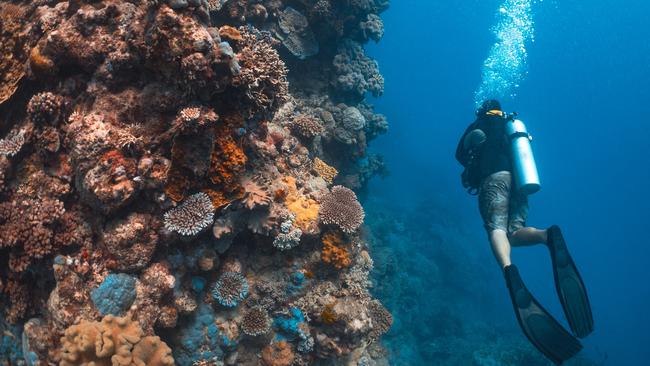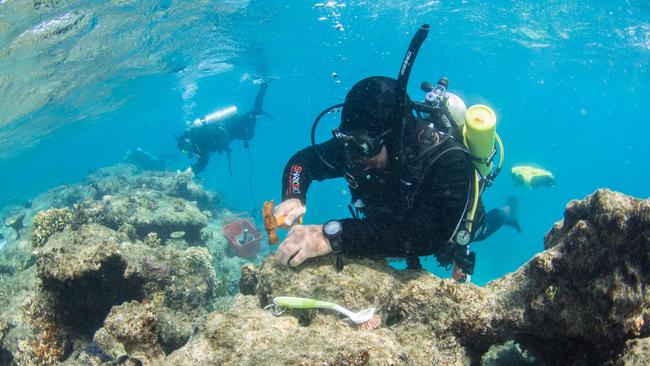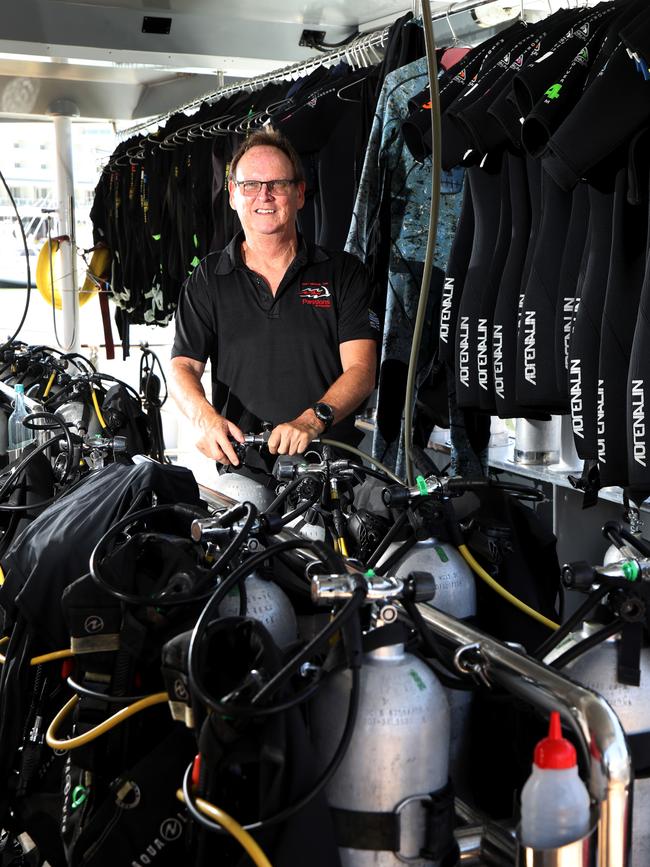Great Barrier Reef tour: planting coral with Passions of Paradise
Who would have thought a hammer and bucket of nails were essential tools in preserving one of Australia’s greatest treasures?

The Great Barrier Reef is protected by dozens of state and federal laws, yet here I am, banging away at it with a hammer. It feels like an act of pure vandalism on the world’s largest coral reef ecosystem. Thunk, thunk, thunk. The sound of nails being bashed into coral rock must be audible to the snorkellers 12m above me; surely they’re horrified by my actions and those of my two scuba-diving companions.
Rather than desecrating one of Australia’s (if not the world’s) most precious environments, we are nurturing it; “planting” coral as part of a collaboration between scientists at University of Technology Sydney and tourism operators in Cairns and Port Douglas.
Stretching 2300km from Cape York in Queensland’s far north to Bundaberg, the heritage-listed landmark comprises more than 3000 individual reefs and hosts 400 coral species and 5000 marine and mammal species, from migrating humpback whales to minuscule creatures only the trained eye can spy (more on that later). With 25 per cent of the Earth’s marine life depending on coral reefs, it is the very definition of biodiversity.
The UTS project aims to encourage coral growth in areas affected by bleaching, cyclones or the crown-of-thorns starfish.

Passions of Paradise, a family-owned operator taking tours out of Cairns on its comfortable 30m catamaran, joined the program in May 2019, and tourists who have their dive ticket are now able to lend a hand.
The day begins early at the Cairns Reef Fleet Terminal, where I meet PoP master reef guide and environmental sustainability co-ordinator Russell Hosp. The burly American first came to Cairns as an exchange student, studied sustainable tourism in Perth and recently obtained his Australian citizenship.
He began working for the business 12 years ago, washing dishes and lifeguarding. These days, when he’s not taking guests diving, he’s counting marine species and assessing coral health and water quality to send weekly reports to the Marine Park Authority’s Eye on the Reef monitoring program. It’s just one of the ways Passions of Paradise, a certified carbon-neutral operation, has attained its impressive eco credentials.
Hosp is full of facts and figures about reef conservation but there’s one message above all others he’s keen to get across: “Coral bleaching absolutely does not mean the coral is dead.”
He describes the whitening as a natural occurrence; the coral’s response to warmer water temperatures. It can survive a bleaching event of eight to 12 weeks but takes about 10 years to fully recover. The problem, Hosp says, is northern sections of the Great Barrier Reef have experienced three mass bleaching events in five years, with the 2016-17 season resulting in mortality rates of 20 to 70 per cent. Hosp doesn’t deny rising sea temperatures pose serious concerns but he’s also not a catastrophist, and insists tourism can be part of the solution.
Today, we’re heading to Hastings Reef, motoring out of Cairns marina in the early morning sunshine. Upbeat music plays over the speakers as guests snack on fruit and sip mugs of tea and coffee.

Cyclone Yasi wreaked havoc on parts of Hastings in 2011, and PoP has created a coral nursery, comprising six aluminium “cages” that resemble security doors suspended above the sea floor. To plant coral, you first have to harvest it, and PoP has permission to break off small pieces of live organism or collect pieces that have fallen on to the seabed. The idea is that four nurseries will eventually provide a steady source of coral for planting.
Clad in stinger suits and scuba gear, we plunge in. Hosp is carrying a “toolbox” of equipment and is accompanied by a hi-tech offsider nicknamed Bumblebee, an $8000 yellow and black autonomous drone that will film our activities, tracking Hosp’s every underwater move like a faithful puppy.
At a depth of about 12m, Hosp starts harvesting, hammering off fingers of staghorn coral. Earlier on the boat, he described them as “fragments of opportunity”. Big pieces are almost impossible to replant but smaller fragments are more likely to sprout.
We’re led to a cage and shown how to remove algae from the frame with a washing-up brush then attach pieces of coral with cable ties. These little “babies” have a survival rate of 70 to 75 per cent and can grow between 10cm and 30cm a year. When it comes to reef conservation, patience is certainly a virtue.
“This is a long-term project,” says Hosp. “We’re not thinking about what it’s going to look like in a year. We’re thinking about what these sites are going to look like in five or 10 years.”
Now for the next phase in our underwater endeavours. We approach a section of the reef where healthy coral grows in abundance at lower depths but the upper levels are largely bare, wiped out by Yasi a decade ago. This is coral rock, technically long-dead coral that Hosp describes as the “building blocks of coral reef”. “[It’s an] underwater galaxy of microbes, viruses. It’s teeming with microscopic life. That’s what the new corals will grow on.”
Hosp produces a bucket piled with patented masonry nails that have a wire clip attached. I take a nail, brush off a patch of rock, and start hammering. Once it’s in position, a coral offshoot is slipped under the wire.

It’s awkward to be performing these tasks while submerged, and I struggle to juggle tools and coral while maintaining my position and neutral buoyancy. But by the second dive, I have found a rhythm and my actions become almost hypnotic. Swim, brush, hammer, clip, repeat. I plant about a dozen corals and can’t help but wonder about their future. As I slot my last piece into place, I give it a wave. Good luck, little one.
Alan Wallish, who founded Passions of Paradise more than 30 years ago, describes how the program has brought the scientific community and tourism operators together, and given him, personally, a sense of stewardship.
“It’s one of the best things I’ve ever done. You’re taking this little coral and it’s a living creature … they’re not plants. And you’re transplanting it and hoping it will grow from this to this,” he says, gesturing with his hands. “You’re actually part of its life cycle. There’s a sense of being part of the whole system.”
Meanwhile, Hosp has been gratified by the 100 per cent positive response from divers when asked if they’d like to help him plant coral. “I’ve yet to have one certified diver who goes, ‘No I don’t want to do any conservation. I’d much rather take my GoPro and chase mermaids’.”

Sitting nearby on the boat, with a serious underwater camera to hand, is Northern Irishman John Magee, a macrophotographer. Someone mentions a pic he took the previous week on a dive with PoP. He flicks through images on his phone, alighting on a snap of the most extraordinary creature. It is a hairy ghost pipefish, otherwise known as a red setter; a 5cm-long apparition covered in wispy auburn “hair” with a translucent snout, one eye staring directly into the lens.
The Great Barrier Reef may be vast, but within it are some astonishing tiny creations.
In the know
Passions of Paradise runs full-day tours to the reef five days a week; adults $185, including $10 reef tax, lunch, morning and afternoon tea, stinger suit and snorkelling gear. Scuba diving is an optional extra. Private charters available. The reef tour and eco-experience for certified divers takes place on Fridays; $399 with all gear provided.
Penny Hunter was a guest of Passions of Paradise and Tourism Tropical North
Queensland.


To join the conversation, please log in. Don't have an account? Register
Join the conversation, you are commenting as Logout